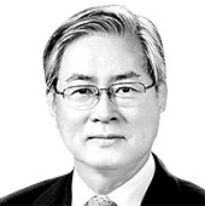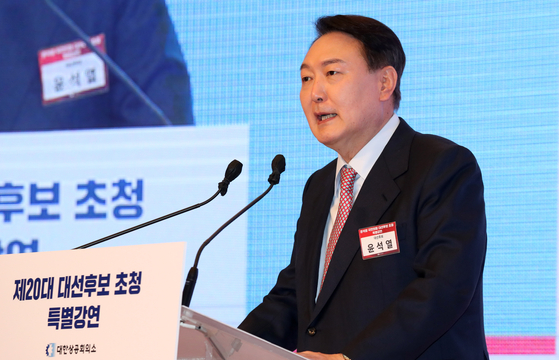Saving the economy through structural reform
Published: 15 Mar. 2022, 19:53

Kim Dong-won
The author is a former visiting professor of economics at Korea University.
President-elect Yoon Suk-yeol presents his economic vision in a speech to members of the Korea Chamber of Commerce and Industry one month before the March 9 presidential election.
From the perspective of economics, the outcome of the latest presidential election showed the public has given a mission to the opposition People Power Party (PPP) to restore the country’s economy. Opinion polls conducted before the March 9 election showed that a majority of the people wanted a change in the ruling power, and the voters chose the opposition candidate.
As public dissatisfaction over the Moon Jae-in administration’s economic failures spread, PPP candidate Yoon Suk-yeol appeared to have benefitted. But it is hard to believe that the voters chose Yoon and the PPP because of any innate capabilities to resolve the economic crisis.
The Moon administration will be remembered for ideologically-biased economic policies. The National Assembly passed over 4,100 bills to tighten regulations and worsen the business environment. As a result, the dynamism of private companies was hobbled and the market was distorted.
Of the Roh Moo-hyun, Lee Myung-bak, Park Geun-hye and Moon administrations, the Moon government achieved the lowest economic growth and the highest rate of government contribution to growth. Moreover, its income-led growth policy boosted general government liabilities (D2) — which include all accounts and funds of the central government and local governments and non-profit public institutions — by a whopping 32 percent, or 228 trillion won ($183.5 billion), over the past five years.
Moon’s housing policy increased the period needed to purchase a median price apartment with a median income from 11 years in December 2016 to 20 years in December 2021. As a result, the young generation no longer has hopes for a better future.
When the Yoon administration launches on May 10, the new president must return the center of economic operations from the government to the private sector and normalize the market through deregulation. Dynamics of growth must be revived and a sustainable balance between growth and fiscal affordability should be restored as top priority for the expansion of social safety networks.

For the new president, normalizing the management of the economy will be a political challenge as the PPP is outnumbered by the Democratic Party (DP). Even if that political hardship is overcome, it will be just a precondition for the success of Yoon’s economic policy.
In a speech to the U.S. Congress in September 2021, U.S. President Joe Biden said, “We stand, in my view, at an inflection point in history.” How about the Korean economy?
First, the population over 65 years old will account for more than 20 percent of the entire population during Yoon’s presidency, making Korea a super-aging society. The growth rate of the elderly population also will increase to 5.2 percentage points in the Yoon administration from 3.4 percentage points in the Moon administration, according to Statistics Korea. By 2027 — the starting year for the next administration — the number will be lowered to 4.6 percentage points, the office estimated.
If the Yoon administration fails to create a social safety network for a super-aged society, including national pensions, irreversible low growth and poverty for the elderly will plague the country.
Second, the fate of the Korean economy will be determined during Yoon’s presidency — whether Korea will become one of the world’s four manufacturing superpowers or not. Some industries such as semiconductors and automobiles are leading the world market, but the competitiveness of the manufacturing industry in general is in crisis due to anemic investments.
From 2017 to 2020, the annual average facilities investment in the manufacturing sector, excluding semiconductors, was just 84 percent of the amount in 2016. As investments slowed, the domestic supply volume of the manufacturing industry decreased by 1.6 percent in 2021 from 2016, but the import volume increased by 33.5 percent. In a golden era of technological innovation, Korea’s manufacturing sector’s competitiveness is at a crossroads.
Third, the global economy is not only threatened by inflation but also by stagflation. The United States is already going through its worst inflation in 40 years. After Russia’s invasion of Ukraine triggered a supply shock, the threat of inflation will only grow. As inflation lowers the actual purchasing power of households, it will shrink consumption and trigger an economic setback. In this case, global trade will shrink. The Korean economy, where 44 percent of its GDP comes from exports, won’t be able to avoid recession. There is a high possibility that the long-term stagnation we had experienced from 2012 till 2016 will repeat itself.
In other words, a perfect storm is approaching. The best preparation is structural reforms. Policies to strengthen productivity and competitiveness and improve fiscal soundness must be enforced steadily. The problem, however, is that it is politically difficult to push forward structural reforms when the economy is suffering.
Will the Yoon administration be able to complete structural reforms that have been delayed for 20 years since the 1997-98 Asian financial crisis and strengthen the Korean economy’s fundamentals to counter the global economic storm? The people are asking the Yoon administration to rescue the Korean economy. Pledges designed to win votes must be reviewed and some must be thrown away. The new government must concentrate its power to save the Korean economy. If the Yoon administration fails, the people will once again demand a change in the governing power in the next presidential election five years from now.
Translation by the Korea JoongAng Daily staff.










with the Korea JoongAng Daily
To write comments, please log in to one of the accounts.
Standards Board Policy (0/250자)